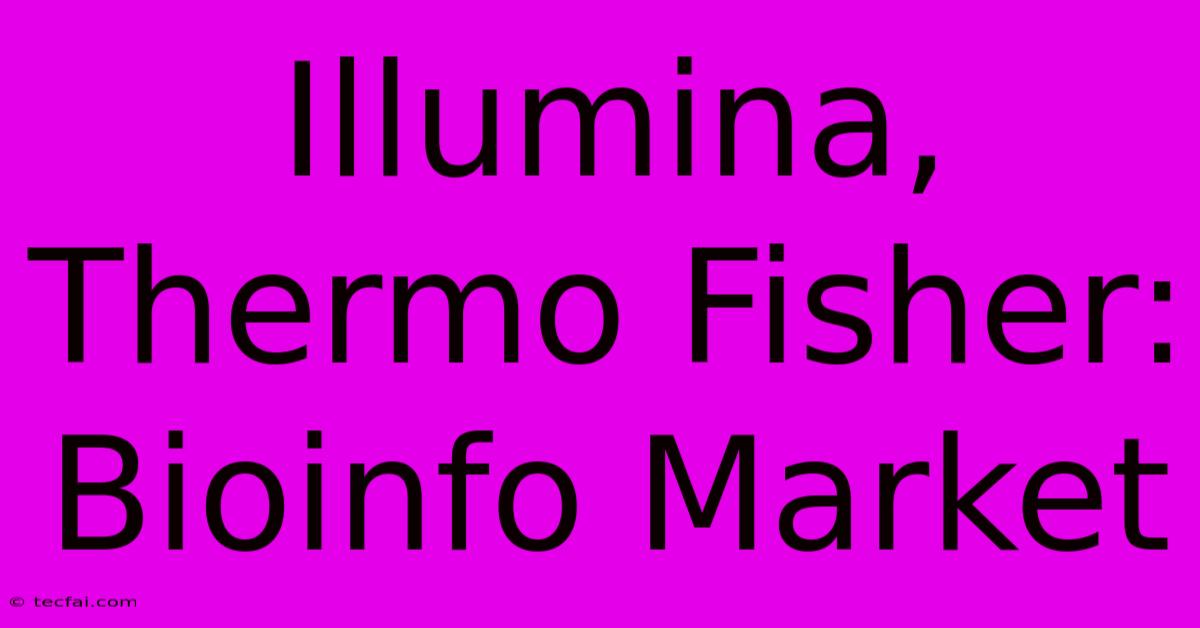Illumina, Thermo Fisher: Bioinfo Market

Discover more detailed and exciting information on our website. Click the link below to start your adventure: Visit Best Website tecfai.com. Don't miss out!
Table of Contents
Illumina vs. Thermo Fisher: Titans Clashing in the Bioinformatics Market
The bioinformatics market is booming, fueled by advancements in genomics, proteomics, and other "omics" fields. At the forefront of this explosive growth are two industry giants: Illumina and Thermo Fisher Scientific. Both companies offer a vast array of technologies and services, but their approaches and market focuses differ significantly. Understanding these differences is crucial for anyone navigating this complex and rapidly evolving landscape.
Illumina: The Sequencing Powerhouse
Illumina is synonymous with next-generation sequencing (NGS). Their dominance in this area is undeniable, with their sequencing platforms setting the standard for high-throughput, accurate genomic data generation. This foundation allows them to offer a comprehensive suite of bioinformatics solutions, including:
- BaseSpace Sequence Hub: A cloud-based platform for data analysis and storage, providing users with a streamlined workflow from raw data to meaningful insights.
- DRAGEN Bio-IT Platform: A highly efficient and scalable bioinformatics platform known for its speed and accuracy in variant calling and other analyses.
- Partnerships and Integrations: Illumina actively collaborates with other bioinformatics companies, expanding its ecosystem and offering users a wider range of analytical tools.
While Illumina’s strength lies primarily in sequencing and related data analysis, their bioinformatics offerings are increasingly integrated with their sequencing hardware and software, creating a cohesive and user-friendly experience, particularly for large-scale genomics projects. However, this close integration can also limit flexibility for users who prefer a more modular approach.
Thermo Fisher Scientific: A Broader Portfolio
Thermo Fisher Scientific takes a more diversified approach. While they offer sequencing technologies, their bioinformatics presence extends far beyond NGS, encompassing a wider range of technologies and applications:
- Applied Biosystems: This Thermo Fisher brand provides a range of instruments and software for PCR, qPCR, and other molecular biology techniques, generating data that require bioinformatics analysis.
- Software Solutions: They offer various software packages for data analysis across different platforms and applications, including mass spectrometry proteomics and clinical diagnostics.
- Cloud-Based Solutions: Similar to Illumina, Thermo Fisher offers cloud-based solutions for data storage and analysis, but their offerings tend to be more modular and integrated with other laboratory informatics systems.
This breadth of offerings makes Thermo Fisher a strong contender for labs with diverse research needs. Their approach caters to a wider range of users, from those focused solely on sequencing to those working across multiple "omics" platforms and clinical applications. However, this breadth might come at the cost of specializing in any one particular area to the same degree as Illumina.
The Competitive Landscape: Key Differences
The key difference boils down to focus. Illumina excels in providing a comprehensive, integrated solution primarily focused on NGS. Thermo Fisher, on the other hand, provides a broader portfolio of tools and services catering to a wider range of scientific applications and experimental methodologies, making them suitable for various laboratory workflows.
The choice between Illumina and Thermo Fisher often depends on specific needs and priorities. Researchers heavily invested in NGS will likely find Illumina's ecosystem particularly appealing. Labs with diverse research interests and a need for broader bioinformatics solutions might find Thermo Fisher's comprehensive portfolio more suitable.
Future Trends: Integration and Artificial Intelligence
The future of the bioinformatics market will likely see increasing integration of different technologies and the application of artificial intelligence (AI) and machine learning (ML). Both Illumina and Thermo Fisher are actively investing in these areas, aiming to enhance the speed, accuracy, and interpretability of bioinformatics analyses. We can expect even more sophisticated cloud-based solutions and automated data analysis pipelines in the coming years. The competition between these giants will continue to drive innovation and push the boundaries of what's possible in the field of bioinformatics.

Thank you for visiting our website wich cover about Illumina, Thermo Fisher: Bioinfo Market. We hope the information provided has been useful to you. Feel free to contact us if you have any questions or need further assistance. See you next time and dont miss to bookmark.
Featured Posts
-
New Zealands Wtc Final Bid
Nov 29, 2024
-
Lampard Seeks Coventry Success
Nov 29, 2024
-
Uk Text Scam Teen Convictions
Nov 29, 2024
-
Haigh Admits Wrongdoing Resigns
Nov 29, 2024
-
Dame Calls Badenoch Wrong Tory Leader
Nov 29, 2024
